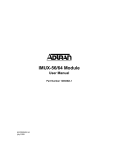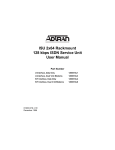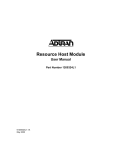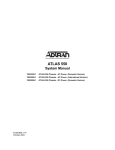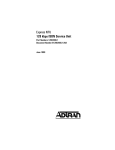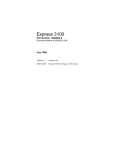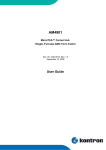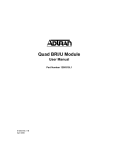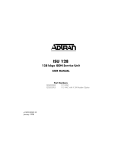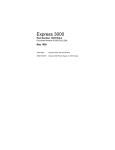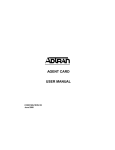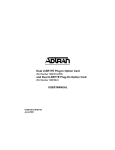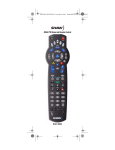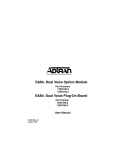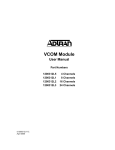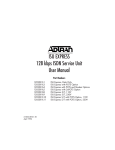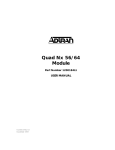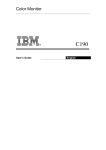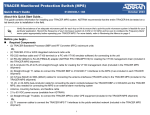Download ATLAS 550 IMUX-56/64 Module User Manual
Transcript
ATLAS 550 IMUX-56/64 Module User Manual Part Number 1200326L1 61200326L1-1A August 2000 901 Explorer Boulevard P.O. Box 140000 Huntsville, AL 35814-4000 (256) 963-8000 © 2000 ADTRAN, Inc. All Rights Reserved. Printed in U.S.A. Federal Communications Commission Radio Frequency Interference Statement: This equipment has been tested and found to comply with the limits for a Class A digital device, pursuant to Part 15 of the FCC Rules. These limits are designed to provide reasonable protection against harmful interference when the equipment is operated in a commercial environment. This equipment generates, uses, and can radiate radio frequency energy and, if not installed and used in accordance with the instruction manual, may cause harmful interference to radio frequencies. Operation of the is equipment in a residential area is likely to cause harmful interference in which case the user will be required to correct the interference at his own expense. Changes or modifications to this unit not expressly approved by the party responsible for compliance could void the user’s authority to operate the equipment. Warranty and Customer Service ADTRAN will replace or repair this product within five years from the date of shipment if the product does not meet its published specification, or if it fails while in service. For detailed warranty, repair, and return information, refer to the ADTRAN Equipment Warranty and Repair and Return Policy Procedures (see the last page of this manual). A return material authorization (RMA) is required prior to returning equipment to ADTRAN. For service, RMA requests, or more information, see the last page of this manual for the toll-free contact number. iii LIMITED PRODUCT WARRANTY ADTRAN warrants that for five (5) years from the date of shipment to Customer, all products manufactured by ADTRAN will be free from defects in materials and workmanship. ADTRAN also warrants that products will conform to the applicable specifications and drawings for such products, as contained in the Product Manual or in ADTRAN's internal specifications and drawings for such products (which may or may not be reflected in the Product Manual). This warranty only applies if Customer gives ADTRAN written notice of defects during the warranty period. Upon such notice, ADTRAN will, at its option, either repair or replace the defective item. If ADTRAN is unable, in a reasonable time, to repair or replace any equipment to a condition as warranted, Customer is entitled to a full refund of the purchase price upon return of the equipment to ADTRAN. This warranty applies only to the original purchaser and is not transferable without ADTRAN's express written permission. This warranty becomes null and void if Customer modifies or alters the equipment in any way, other than as specifically authorized by ADTRAN. EXCEPT FOR THE LIMITEDWARRANTY DESCRIBED ABOVE, THE FOREGOING CONSTITUTES THE SOLE AND EXCLUSIVE REMEDY OF THE CUSTOMER AND THE EXCLUSIVE LIABILITY OF ADTRAN AND IS IN LIEU OF ANY AND ALL OTHER WARRANTIES (EXPRESSED OR IMPLIED). ADTRAN SPECIFICALLY DISCLAIMS ALL OTHER WARRANTIES, INCLUDING (WITHOUT LIMITATION), ALL WARRANTIES OF MERCHANTABILITY AND FITNESS FOR A PARTICULAR PURPOSE. SOME STATES DO NOT ALLOW THE EXCLUSION OF IMPLIEDWARRANTIES, SO THIS EXCLUSION MAY NOT APPLY TO CUSTOMER. In no event will ADTRAN or its suppliers be liable to Customer for any incidental, special, punitive, exemplary or consequential damages experienced by either Customer or a third party (including, but not limited to, loss of data or information, loss of profits, or loss of use). ADTRAN is not liable for damages for any cause whatsoever (whether based in contract, tort, or otherwise) in excess of the amount paid for the item. Some states do not allow the limitation or exclusion of liability for incidental or consequential damages, so the above limitation or exclusion may not apply to Customer. iv Table of Contents List of Figures ....................................................................................................................................................vii List of Tables....................................................................................................................................................... ix Chapter 1. Introduction.................................................................................................................................. 1-1 IMUX-56/64 Module Overview .................................................................................................................... 1-1 Configuring an Endpoint to use BONDING ................................................................................................ 1-1 Functional Description .................................................................................................................................... 1-2 Features ....................................................................................................................................................... 1-2 Physical Description ........................................................................................................................................ 1-3 Chapter 2. Installation.................................................................................................................................... 2-1 Unpack and Inspect ......................................................................................................................................... 2-1 Contents of Adtran Shipment ........................................................................................................................ 2-1 Installing the IMUX-56/64 Module ............................................................................................................... 2-1 Power-up and Initialization ............................................................................................................................ 2-3 Failed Self-test ................................................................................................................................................... 2-3 Chapter 3. Operation ...................................................................................................................................... 3-1 Overview ........................................................................................................................................................... 3-1 Terminal Menu Structure ................................................................................................................................ 3-1 Menu Access ..................................................................................................................................................... 3-2 System Config ................................................................................................................................................... 3-2 BONDING Config .................................................................................................................................... 3-2 TXINIT Timer ..................................................................................................................................... 3-2 TXFA Timer ........................................................................................................................................ 3-2 TXADD01 Timer ................................................................................................................................ 3-3 TXDEQ Timer ..................................................................................................................................... 3-3 TANULL Timer .................................................................................................................................. 3-3 TCID Timer ......................................................................................................................................... 3-3 Call Stagger ......................................................................................................................................... 3-3 Modules ............................................................................................................................................................. 3-4 Slt ................................................................................................................................................................. 3-4 Type ............................................................................................................................................................ 3-4 Menu ........................................................................................................................................................... 3-4 Alarm .......................................................................................................................................................... 3-4 State ............................................................................................................................................................. 3-4 Status .......................................................................................................................................................... 3-5 Rev .............................................................................................................................................................. 3-5 IMUX Menu ...................................................................................................................................................... 3-6 Info .............................................................................................................................................................. 3-6 Part Number ....................................................................................................................................... 3-6 61200326L1-1A IMUX-56/64 Module User Manual v Table of Contents Serial Number .................................................................................................................................... 3-6 Board Revision ................................................................................................................................... 3-6 Firmware Revision ............................................................................................................................. 3-6 Status ........................................................................................................................................................... 3-7 Status ................................................................................................................................................... 3-7 NumBChannels .................................................................................................................................. 3-8 Data Rate ............................................................................................................................................. 3-8 Bonded Ep ........................................................................................................................................... 3-8 Configuration ............................................................................................................................................ 3-8 ATLAS Features used with IMUX-56/64 Module Options ....................................................................... 3-8 Factory Restore ........................................................................................................................................... 3-9 System Self-Test ......................................................................................................................................... 3-9 Index ...........................................................................................................................................................Index-1 vi IMUX-56/64 Module User Manual 61200326L1-1A List of Figures Figure 1-1. ATLAS Remote Access Application ........................................................................................ 1-1 Figure 1-2. Interface Configuration Example ............................................................................................. 1-2 Figure 2-1. ATLAS 550 Rear Chassis ........................................................................................................... 2-2 Figure 3-1. BONDING Config Submenu .................................................................................................... 3-2 Figure 3-2. Modules Menu ............................................................................................................................ 3-4 Figure 3-3. IMUX-56/64 Module Submenus .............................................................................................. 3-6 Figure 3-4. IMUX-56/64 Module Status Menu .......................................................................................... 3-7 Figure 3-5. IMUX-56/64 Module Config Menu ......................................................................................... 3-8 61200326L1-1A IMUX-56/64 Module User Manual vii List of Figures viii IMUX-56/64 Module User Manual 61200326L1-1A List of Tables Table 3-1. Management Methods for the IMUX-56/64 Module ................................................................ 3-1 Table 3-2. Call Stagger Values ......................................................................................................................... 3-3 Table 3-3. Status Messages............................................................................................................................... 3-5 Table 3-4. BONDING Status Display Values ................................................................................................ 3-7 61200326L1-1A IMUX-56/64 Module User Manual ix List of Tables x IMUX-56/64 Module User Manual 61200326L1-1A Chapter 1 Introduction IMUX-56/64 MODULE OVERVIEW The IMUX-56/64 Module combines with other ATLAS components to provide a flexible disaster recovery system in the ATLAS Integrated Access System. The IMUX-56/64 Module supports multiple, independent BONDING sessions with each session having the potential to use a different bandwidth. The IMUX-56/64 Module can use either 56Kbps or 64Kbps data lines (i.e., channels) for any given BONDING session. The IMUX-56/64 Module can establish a BONDING session using as few as 2 or as many as 32 channels. Figure 1-1 shows an example application of the IMUX-56/64 Module. Branch Office Headquarters TSU IQ T1/fT1 T1 ATLAS 550 with IMUX-56/64 BRI or PRI Router DBU ISU 512 Frame Relay PSTN BRI (x4) T1/fT1 BRI (x4) Branch Office TSU IQ Router DBU ISU 512 Figure 1-1. ATLAS Remote Access Application CONFIGURING AN ENDPOINT TO USE BONDING The manner in which an endpoint is configured to use BONDING is unique to each type of endpoint. Typically, it will be a reference to the number of DS0s, with mention of BONDING in the help line. See the ATLAS 550 or 550 manuals for more information on endpoint configuration. Information may 61200326L1-1A IMUX-56/64 Module User Manual 1-1 Chapter 1. Introduction also be found in the help menus under the endpoint’s Dial Plan Interface configuration. For example, to configure an Nx endpoint for BONDING, set Max DS0s and Min DS0s to something other than 1 under the Nx Dial Plan interface configuration (see Figure 1-2). Figure 1-2. Interface Configuration Example FUNCTIONAL DESCRIPTION The IMUX-56/64 Module installs onto any option module that can be installed into one of the four user slots of the ATLAS 550 chassis. You can view the module status from the ATLAS 550 front panel LEDs (also see Chapter 4 of the ATLAS 550 User Manual). You can also use the terminal menus to provide additional status information, configure the module, and download application software. Access the terminal menus via either a VT-100 terminal connected to the ATLAS 550 Base Unit's control port or a Telnet session established through the Base Unit's Ethernet port. Features • 1-2 Compliant with TIA/EIA-619 Standard (BONDING) - Up to (16) 128Kbps BONDING sessions per module - Up to (4) 512Kbps BONDING sessions per module - Up to (1) 2.048Mbps BONDING sessions per module • Event-driven dial-backup of frame relay or T1 circuits • Support for 56K or 64K circuits • Video conferencing support • Software upgrades via FLASH download IMUX-56/64 Module User Manual 61200326L1-1A Chapter 1. Introduction PHYSICAL DESCRIPTION The IMUX-56/64 Module provides no external interfaces. Other ATLAS 550 components provide both the network and customer interfaces. An internal bus exchanges information between the ATLAS 550 chassis and the IMUX56/64 Module. 61200326L1-1A IMUX-56/64 Module User Manual 1-3 Chapter 1. Introduction 1-4 IMUX-56/64 Module User Manual 61200326L1-1A Chapter 2 Installation UNPACK AND INSPECT Carefully inspect the IMUX-56/64 Module for shipping damages. If you suspect damage, file a claim immediately with the carrier and then contact ADTRAN Technical Support at the number provided in the back of this manual. If possible, keep the original shipping container for returning the IMUX-56/64 Module for repair or for verification of shipping damage. CONTENTS OF ADTRAN SHIPMENT The ADTRAN shipment includes the following items: • IMUX-56/64 Module • IMUX-56/64 Module User Manual (Insert into main ATLAS 550 User Manual.) INSTALLING THE IMUX-56/64 MODULE The IMUX-56/64 module must be attached to an ATLAS 550 option module before the IMUX-56/64 module may be installed into the ATLAS 550 unit. The IMUX-56/64 module cannot be installed into an ATLAS 550 chassis without being first attached to an ATLAS 550 option module. The IMUX-56/64 module can be attached to any type of ATLAS 550 option module and the resulting assembly can then be installed into any option module slot of the ATLAS 550 chassis. Only an ATLAS 550 option module can be used to carry the IMUX-56/64 module. In particular, the IMUX-56/ 64 module cannot be attached to any network module or inserted into any network module slot of the ATLAS 550 chassis. To install the IMUX-56/64 module onto an ATLAS 550 option module and then into the ATLAS 550 unit, use the following procedure. 61200326L1-1 IMUX-56/64 Module User Manual 2-1 Chapter 2. Installation Instructions for Installing the IMUX-56/64 Module Step 1 Action On the rear of the ATLAS 550 chassis, remove the cover plate covering the slot into which the option module carrying the IMUX56/64 module is to be inserted. If theATLAS 550 option module is already in the ATLAS 550 chassis, simply loosen the thumbscrews at both edges of the option module faceplate and slide the module out of the chassis. Carefully align the P10 connector on the IMUX-56/64 module with the J10 connector on the option module. 2 Using only fingertip pressure, so that neither circuit board bends or flexes, ensure that the connectors are firmly seated. Secure the opposite end of the IMUX-56/64 module to the option module using the screws and standoff posts supplied. 3 Slide the option module, with the IMUX-56/64 module attached, into the ATLAS 550 chassis until the module is positioned firmly against the front of the ATLAS unit. 4 Fasten the thumbscrews at both edges of the option module faceplate. Tighten with a screwdriver. 5 Install any additional modules into the base unit, as specified in the Installation chapter of the ATLAS 550 User Manual . Figure 2-1 shows the proper placement of the IMUX-56/64 Module in the ATLAS 550 chassis. IMUX Module Remove Cover Plate 1 O O I 4 ALL EMPTY SLOTS MUST BE COVERED WITH BLANK PANELS NETWORK 2 FUSE RATING: 2A/250V SLO-BLO ETHERNET CONTROL IN OUT RELAY MON CAUTION: FOR CONTINUED PROTECTION AGAINST RISK OF FIRE, REPLACE ONLY WITH SAME TYPE AND RATING OF FUSE. 2 DUAL T1 / PRI MON 500 Series 2 I 90-240VAC, 2A, 50/60Hz ALARM Option Module NC NO COM GND Figure 2-1. ATLAS 550 Rear Chassis Option modules are intended to be serviced by qualified service personnel only. 2-2 IMUX-56/64 Module User Manual 61200326L1-1 Chapter 2. Installation POWER-UP AND INITIALIZATION After installing the IMUX-56/64 Module into the ATLAS 550 chassis, the front panel STATUS indicator blinks red, yellow, and green for a time. The STATUS indicator remains solid green when the IMUX-56/64 Module is ready to use. At this time, you can invoke a system self-test; refer to the ATLAS 550 User Manual for details. This self-test sequence may take up to eleven (11) minutes. FAILED SELF-TEST The terminal menu self-test log records any self-test failures for the IMUX56/64 module. Resources that fail self-test are disabled after power-up initialization is complete. Performing a hardware-level reset via the terminal menu may recover these failed resources. 61200326L1-1 IMUX-56/64 Module User Manual 2-3 Chapter 2. Installation 2-4 IMUX-56/64 Module User Manual 61200326L1-1 Chapter 3 Operation OVERVIEW You can configure and control the IMUX-56/64 Module from two sources, as shown in Table 3-1. The ATLAS User Manual provides detailed instructions on operating each of the supported management approaches. The remainder of this chapter describes the menu items available for managing the IMUX-56/64 Module using the terminal menu. Table 3-1. Management Methods for the IMUX-56/64 Module Source Purpose Terminal Menu For detailed configuration, status, and diagnostics Simple Network Management Protocol (SNMP) For reporting alarm conditions and system status (no configuration) You must have the appropriate password level to edit items using the terminal menu. (See the section Access Passwords in the ATLAS User Manual for detailed information on working with passwords.) Security level 1 users can view and edit every available field. Security level 5 users can view any field, but they cannot edit. Each menu description in this section indicates the required password level required for write and read access. TERMINAL MENU STRUCTURE ATLAS uses hierarchical menus to access all of its features. The top-most menu level leads to submenus which are grouped by functionality. All submenu options display in the VT-100 terminal window. You can use the Modules terminal menu to configure and control the IMUX-56/64 Module. The Modules menu option, Type, shows the IMUX-56/ 64 Module as IMUX (see Figure 3-2). The following sections describe the Modules menu and its submenus. 61200326L1-1A IMUX-56/64 Module User Manual 3-1 Chapter 3. Operation MENU ACCESS The ATLAS System Controller automatically detects the presence of the IMUX-56/64 Module when it is installed in the system. To access menus and submenus, use the keyboard arrow keys to scroll to the appropriate row and column; then press Enter on the keyboard. For example, to view the Menus submenu for IMUX, use the keyboard arrow keys to move to the row IMUX and the column Menu; then press Enter on the keyboard. Refer to the ATLAS User Manual for detailed instructions on how to navigate through the terminal menu. SYSTEM CONFIG The IMUX-56/64 Module includes a BONDING Config submenu under the System Config menu. The following paragraphs describe this submenu. BONDING Config Write security: 5; Read security: 5 Displays the configuration submenus available for the IMUX-56/64 Modules. This configuration is shared among all IMUX-56/64 Modules (see Figure 3-1). Figure 3-1. BONDING Config Submenu TXINIT Timer Write security: 3; Read security: 5 Specifies the length of time the originating endpoint attempts to detect the BONDING negotiation pattern from the answering endpoint before deciding the BONDING call has failed. TXFA Timer Write security: 3; Read security: 5 Specifies the length of time both endpoints attempt to detect the BONDING frame pattern when a call is connected before deciding the BONDING call has failed. When interoperating with other manufacturers' BONDING 3-2 IMUX-56/64 Module User Manual 61200326L1-1A Chapter 3. Operation equipment, it may be necessary to change this time so that it matches TXADD01. TXADD01 Timer Write security: 3; Read security: 5 Specifies the length of time both endpoints wait for additional calls to be connected at the end of negotiation before deciding that the BONDING call has failed. The factory default setting is sufficient for most calls to connect, although when dialing overseas it may be necessary to lengthen this timer to allow for slower call routing. TXDEQ Timer Write security: 3; Read security: 5 Specifies the length of time both endpoints attempt to equalize the network delay between the bearer channels before deciding the BONDING call has failed. TANULL Timer Write security: 3; Read security: 5 Specifies the length of time the answering endpoint attempts to detect the BONDING negotiation pattern from the originating endpoint before deciding the BONDING call has failed. It may be necessary to shorten this timer if the DTE equipment using the BONDING module also has timer constraints for completing non-BONDING parameter negotiation. TCID Timer Write security: 3; Read security: 5 Specifies the length of time both endpoints attempt to negotiate an agreeable value for bearer channels and channel capacities before deciding the BONDING call has failed. Call Stagger Write security: 3; Read security: 5 Specifies the amount of delay between placing calls for outgoing BONDING sessions. Table 3-2 defines the call stagger values. Table 3-2. Call Stagger Values Display value Meaning No Stagger There is no delay between the call dialing of a BONDING session. 500 ms Wait approximately ½ second between the call dialing of a BONDING session. 1 sec Wait approximately 1 second between the call dialing of a BONDING session. 2 sec Wait approximately 2 seconds between the call dialing of a BONDING session. 61200326L1-1A IMUX-56/64 Module User Manual 3-3 Chapter 3. Operation MODULES The following paragraphs (Slt (slot), Type, Menu, Alarm, State, Status, and Rev (revision)) describe the IMUX-56/64 Modules fields (see Figure 3-2). Figure 3-2. Modules Menu Slt Read security: 5 (Slot) Displays the number of available slots in the ATLAS chassis. Slot 0 refers to the ATLAS Base Unit. Type Write security: 3; Read security: 5 Displays the module type currently installed in the slot or the module type you plan to install in the slot. If an IMUX-56/64 Module is installed, the Type field automatically defaults to IMUX (the IMUX-56/64 Module). You can use this field to preconfigure the system before installing modules by specifying the module that you want to install into each slot. If a module is installed, Type automatically displays the name of the installed module, and it cannot be set to any other option. Menu Read security: 5 Displays additional status and configuration submenus for the IMUX-56/64 Module. (To access the submenus for this item, use the arrow keys to scroll to the Menu column for the module you want to edit, and press Enter.) Alarm Read security: 5 Displays whether there is an alarm condition on the IMUX-56/64 Module. Press Enter in this field to activate the Alarm menu. State Read security: 5 Displays whether the module is online or offline. Even though a module is physically installed, it must be marked Online for it to be considered an available resource. Marking an installed module Offline may be useful in 3-4 IMUX-56/64 Module User Manual 61200326L1-1A Chapter 3. Operation system troubleshooting. If you choose Offline, the module will not be in alarm condition, but will display Offline. Only if State reads Online, can the ATLAS use an installed module for any data bandwidth. Status Read security: 5 Displays status information on the IMUX-56/64 Module. Table 3-3 describes status messages that may appear and their meanings. Rev Read security: 5 (Hardware Revision) Displays the hardware revision of the IMUX-56/64 Module. Table 3-3. Status Messages Message Meaning Comments Online The module is enabled and is responding to the system controller’s status polls. No Response The module is enabled but is not responding to the This response indicates either a system controller’s status polls. problem in the system or the module is not installed. Empty The system controller has not detected the presence of a module in the option slot, nor has a module been manually enabled for this option slot. Offline The module is installed but has been taken Offline by a user. The module is still responding to controller polls. Offline / No Response The module is installed but has been taken Offline by a user. The module is not responding to polls. This response indicates either a problem in the system or the module is not installed. Not Ready The module is installed and performing startup initialization. The initialization of the IMUX56/64 should take less than 10 seconds. 61200326L1-1A IMUX-56/64 Module User Manual This is the normal response of the system. 3-5 Chapter 3. Operation IMUX MENU The IMUX Menu fields include Info, Status, and Configuration (see Figure 33). Figure 3-3. IMUX-56/64 Module Submenus Info Read security: 5 Displays module and software information for the option module. Part Number Read security: 5 Displays the IMUX-56/64 Module part number in a read-only field. Serial Number Read security: 5 Displays the IMUX-56/64 Module serial number in a read-only field. Board Revision Read security: 5 Displays the printed circuit board revision of the IMUX-56/64 Module in a read-only field. Firmware Revision Read security: 5 Displays the firmware revision of the IMUX-56/64 Module in a read-only field. 3-6 IMUX-56/64 Module User Manual 61200326L1-1A Chapter 3. Operation Status Read security: 5 Displays the Status submenus for BONDING resources available on the IMUX-56/64 Module (see Figure 3-4). Figure 3-4. IMUX-56/64 Module Status Menu Status Read security: 5 Indicates the current status of a particular BONDING session. Table 3-4 defines the possible status display values. Table 3-4. BONDING Status Display Values Display Value Meaning Idle Indicates the number of Idle BONDING resources for a particular BONDING engine. Reserved BONDING resources reserved for a BONDING session that is in the process of coming up. Negotiating A single channel is connected and negotiating the BONDING call for a particular BONDING session. Add Channels The initial BONDING negotiation was successful, and the IMUX-56/64 Module is in the process of adding channels to the BONDING session. BONDING The remaining channels were brought up successfully, and the BONDING session is now ready to pass data. Terminated The BONDING session has been terminated for some reason and is in the process of freeing BONDING resources. 61200326L1-1A IMUX-56/64 Module User Manual 3-7 Chapter 3. Operation NumBChannels Read security: 5 Displays the number of bearer channels used in this BONDING session. When the number is displayed in the format X/Y, Y is the number of BONDING resources reserved for this session, and X is the number of calls belonging to this session that are up. If just a number is displayed, then all calls are up, and the number displayed is the number of BONDING resources in use for this session. Data Rate Read security: 5 Displays the data rate for this BONDING session. The number in the parenthesis is the data rate of the individual bearer channels. Bonded Ep Read security: 5 Displays the slot and port of the terminating endpoint that is using this BONDING session. Configuration Read security: 5 Displays the configuration submenus available for the IMUX-56/64 Module (see Figure 3-5). Changes to the configuration of any IMUX-56/64 Module will be propagated to all IMUX-56/64 Modules. Figure 3-5. IMUX-56/64 Module Config Menu For a description of the individual timers, see BONDING Config on page 3-2. ATLAS FEATURES USED WITH IMUX-56/64 MODULE OPTIONS In addition to the IMUX-56/64 Module menu items, two additional ATLAS menu items may be operated in conjunction with the IMUX-56/64 Module. These are Factory Restore and System Self-test. 3-8 IMUX-56/64 Module User Manual 61200326L1-1A Chapter 3. Operation Factory Restore Individual IMUX-56/64 Modules do not have independent configurations; there is one configuration for all IMUX-56/64 Modules in an ATLAS. This configuration can be returned to factory default by pressing F while the cursor is positioned over the BONDING Config submenu, found in the System Config menu. Factory defaulting an individual IMUX-56/64 Module will not affect the configuration. System Self-Test System Self-test, a submenu of the ATLAS main menu item System Utility, executes both the IMUX-56/64 Module internal test and the ATLAS internal test. The results of the self-test are displayed in the self-test log. The unit continuously updates the display on the self-test log screen until all test results are shown. For additional information on self-test, see the ATLAS User Manual. 61200326L1-1A IMUX-56/64 Module User Manual 3-9 Chapter 3. Operation 3-10 IMUX-56/64 Module User Manual 61200326L1-1A Index A M accessing menus 3-2 Alarm 3-4 ATLAS features 3-8 ATLAS system controller 3-2 Menu 3-4 menu structure 3-1 modem features 1-2 Modules 3-4 B Board Revision 3-6 Bonded Ep 3-8 BONDING 1-1 BONDING Config 3-2 BONDING status display values 3-7 N NumBChannels 3-8 O C offline state 3-4 online state 3-4 Call Stagger 3-3 call stagger values 3-3 configuring IMUX-56/64 module 3-1 P D Data Rate 3-8 description 1-1, 1-3 Part Number 3-6 password levels 3-1 R remote access application 1-1 Rev 3-5 F factory restore 3-8 FCC statement iii features 1-2 Firmware Revision 3-6 S self-test failed 2-3 self-test, system 3-9 Serial Number 3-6 shipping contents 2-1 damage 2-1 H hardware revision 3-5 I IMUX Menu 3-6 Info 3-6 initializing the module 2-3 installing the IMUX-56/64 module 2-1 61200326L1-1 IMUX-56/64 Module User Manual Index-1 Index Slt 3-4 State 3-4 Status 3-5, 3-7 status messages for Modem-16 3-5 System Config 3-2 system self-test 3-8, 3-9 T TANULL Timer 3-3 TCID Timer 3-3 terminal menu navigating 3-2 Index-2 terminal menu structure 3-1 tests system self-test 3-8 TXADD01 Timer 3-3 TXDEQ Timer 3-3 TXFA Timer 3-2 TXINIT Timer 3-2 Type 3-4 type menu 3-4 IMUX-56/64 Module User Manual 61200326L1-1 Product Support Information Presales Inquiries and Applications Support Please contact your local distributor, ADTRAN Applications Engineering, or ADTRAN Sales: Applications Engineering (800) 615-1176 Sales (800) 827-0807 Post-Sales Support Please contact your local distributor first. If your local distributor cannot help, please contact ADTRAN Technical Support and have the unit serial number available. Technical Support (888) 4ADTRAN Repair and Return If ADTRAN Technical Support determines that a repair is needed, Technical Support will coordinate with the Customer and Product Service (CAPS) department to issue an RMA number. For information regarding equipment currently in house or possible fees associated with repair, contact CAPS directly at the following number: CAPS Department (256) 963-8722 Identify the RMA number clearly on the package (below address), and return to the following address: ADTRAN Customer and Product Service 6767 Old Madison Pike Progress Center Building #6 Suite 690 Huntsville, Alabama 35807 RMA # _____________
































